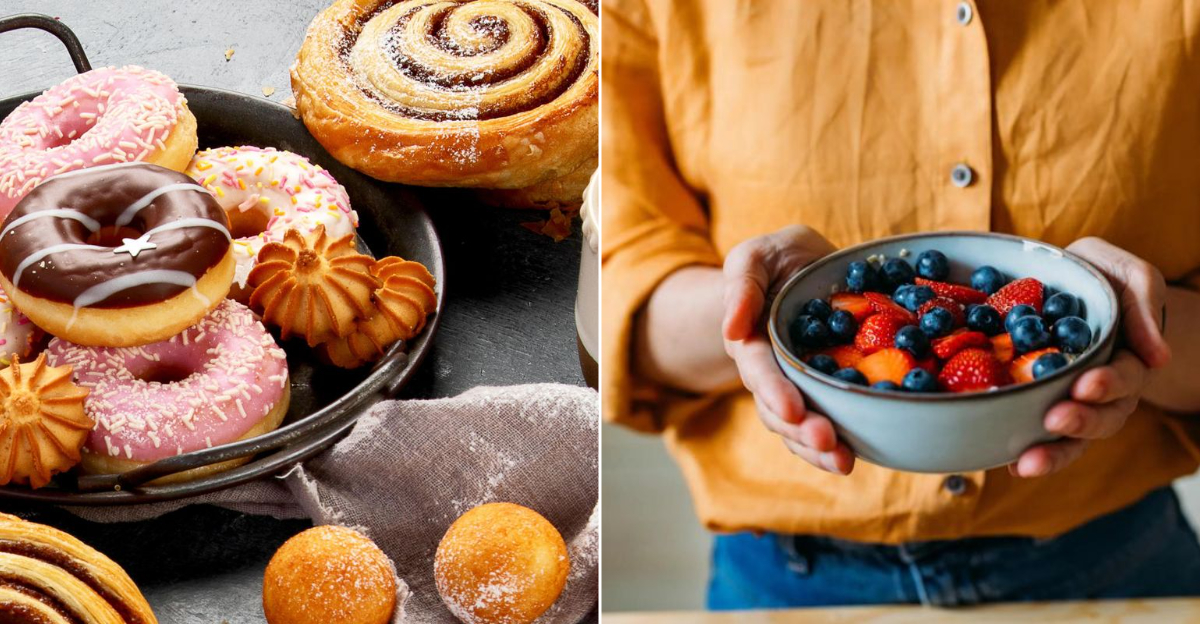9 Foods That Spike Your Insulin And 9 That Keep It In Balance

Your body’s relationship with insulin can make or break your health goals. This hormone controls your blood sugar levels and affects everything from your energy to your weight.
Knowing which foods send your insulin soaring and which keep it steady puts you in the driver’s seat of your health journey. Let’s explore the dietary heroes and villains in the insulin story!
1. White Bread: The Fluffy Blood Sugar Betrayer
That innocent-looking slice of white bread is actually a sugar bomb in disguise! Refined flours have had all their fiber stripped away, leaving nothing to slow down digestion.
Your body converts white bread to glucose almost immediately, causing your insulin to skyrocket. I once ate two slices before a meeting and nearly fell asleep at my desk from the crash afterward.
Switch to whole grain options that take longer to digest and won’t send your blood sugar on a roller coaster ride.
2. Sugary Sodas: Liquid Insulin Disasters
Pop open a can of regular soda and you’re basically mainlining 39 grams of sugar straight into your bloodstream. These fizzy favorites cause one of the fastest and highest insulin responses of any food or drink.
Without fiber, fat, or protein to slow absorption, your pancreas panics and pumps out insulin at emergency levels. Even diet versions can trick your body into an insulin response through artificial sweeteners.
Reach for sparkling water with a splash of real fruit instead.
3. White Potatoes: Starchy Insulin Triggers
Those perfectly crispy french fries might satisfy your taste buds, but they’re setting off insulin alarms throughout your body. White potatoes rank surprisingly high on the glycemic index—sometimes even above table sugar!
Growing up, my grandmother always served mashed potatoes with every meal, never understanding why her diabetes was so hard to control. The starch in potatoes converts rapidly to glucose, especially when they’re processed into fries or chips.
Preparation matters too as boiled potatoes cause less insulin response than baked or mashed.
4. Breakfast Cereals: Morning Insulin Spike Starters
The colorful boxes lining grocery store shelves hide a troubling secret: many breakfast cereals pack more sugar than dessert! Even “healthy” options often contain hidden sweeteners that trigger significant insulin responses.
The combination of refined grains and added sugars creates the perfect storm for blood sugar chaos. Most cereals lack sufficient protein or fiber to offset their insulin-spiking effects.
Check labels carefully—anything with more than 5g of sugar per serving is moving into dessert territory, not breakfast material.
5. White Rice: The Deceptively Simple Insulin Elevator
That innocent-looking bed of white rice beneath your stir-fry is secretly spiking your insulin levels. The polishing process removes the fiber-rich bran and germ, leaving just the easily digested endosperm.
Your body converts white rice to blood sugar nearly as quickly as it does table sugar. Interestingly, cooling cooked rice in the refrigerator before eating can lower its glycemic impact by increasing resistant starch content.
Brown, black, or wild rice varieties maintain their fiber, slowing digestion and reducing insulin demands.
6. Fruit Juices: Nature’s Sugar Concentrate
Strip away the fiber from fruit and what remains is essentially sugar water with some vitamins. Even 100% natural fruit juices cause rapid insulin spikes comparable to soda because they’ve lost the fiber that normally slows sugar absorption.
A glass of orange juice requires 3-4 oranges but takes seconds to consume—delivering all their sugar without the satiety benefits of whole fruit. The fructose overload can also contribute to insulin resistance over time.
Eat whole fruits instead, where fiber remains intact and slows sugar absorption.
7. Processed Pastries: Insulin-Spiking Sweet Treats
Doughnuts, muffins, and pastries create the perfect insulin-spiking storm—combining refined flour, added sugars, and unhealthy fats. These breakfast imposters can contain up to 40 grams of sugar per serving!
The combination of simple carbs and fats is particularly problematic for blood sugar control. During college, I grabbed a chocolate croissant every morning before class, wondering why I couldn’t stay awake through my 10 AM lecture.
Your body processes these treats like dessert, triggering massive insulin release followed by energy crashes.
8. Flavored Yogurts: Sugar-Laden Dairy Deceptions
Behind the health halo of many flavored yogurts lurks an insulin-spiking surprise—up to 7 teaspoons of added sugar per cup! The fruit at the bottom or blended throughout is typically more syrup than actual fruit.
What makes this especially tricky is yogurt’s reputation as a health food. The protein content does help moderate blood sugar response somewhat, but can’t fully counteract the added sweeteners.
Plain yogurt with fresh berries gives you probiotic benefits without the insulin roller coaster.
9. Instant Oatmeal Packets: Sneaky Morning Sugar Surge
Those convenient oatmeal packets promising a quick, healthy breakfast are often insulin disasters in disguise. Many contain 3-4 teaspoons of added sugar plus highly processed oats that digest rapidly.
The processing required to make oats “instant” dramatically increases their glycemic impact compared to steel-cut or rolled varieties. The finer texture means faster digestion and quicker blood sugar spikes.
Steel-cut oats take longer to cook but create a much gentler insulin response, keeping energy levels stable throughout the morning.
10. Avocados: Creamy Blood Sugar Stabilizers
Slice into an avocado and you’re accessing nature’s insulin-friendly fat package. These green gems contain primarily monounsaturated fats that slow digestion and prevent blood sugar spikes after meals.
My diabetic uncle started adding half an avocado to his breakfast and saw morning blood sugar readings improve within a week. The fiber content—about 9 grams per avocado—further helps moderate glucose absorption.
Their high potassium content also supports insulin sensitivity, making cells more responsive to insulin’s signals.
11. Wild Salmon: Omega-3 Insulin Optimizer
Feast on a fillet of wild salmon and you’re serving up omega-3 fatty acids that actively improve insulin sensitivity. These essential fats reduce inflammation in cell membranes, allowing insulin receptors to function more effectively.
During my pregnancy with gestational diabetes, my doctor specifically recommended wild salmon twice weekly. The protein in salmon also triggers minimal insulin release compared to carbohydrates while keeping you satisfied longer.
Choose wild over farmed when possible for higher omega-3 content and fewer contaminants.
12. Leafy Greens: Nutrient-Dense Insulin Balancers
Pile your plate with spinach, kale, or arugula and you’re building a foundation for stable blood sugar. These verdant vegetables contain virtually no digestible carbs to trigger insulin yet deliver magnesium—a mineral critical for proper insulin function.
The fiber in leafy greens slows the absorption of any carbohydrates eaten alongside them. Their high antioxidant content also helps combat oxidative stress that can damage insulin-producing cells.
Dark varieties like kale and collards offer even more blood sugar benefits than lighter lettuces.
13. Apple Cider Vinegar: Tangy Glucose Response Reducer
Pour a tablespoon of this tangy liquid into water before meals and watch your post-meal blood sugar levels improve. Apple cider vinegar contains acetic acid that appears to block enzymes that digest starch, reducing glucose entering the bloodstream.
I started taking a shot with water before dinner last year and noticed I no longer felt that post-pasta energy crash. Studies show consuming apple cider vinegar before carb-heavy meals can reduce blood sugar response by up to 31%.
Look for unfiltered varieties with “the mother” for maximum benefits.
14. Chia Seeds: Tiny Insulin-Friendly Powerhouses
Sprinkle these tiny black seeds into your smoothie and you’re adding a remarkable blood sugar stabilizer. Chia seeds form a gel-like substance in your digestive tract, creating a physical barrier that slows carbohydrate absorption.
The combination of soluble fiber, protein, and healthy fats creates the perfect trifecta for insulin control. Just one ounce contains an impressive 10 grams of fiber that feeds beneficial gut bacteria linked to improved insulin sensitivity.
Try soaking them overnight in almond milk for a blood-sugar friendly breakfast pudding.
15. Berries: Sweet-Tasting Insulin Regulators
Pop a handful of blueberries or strawberries and you’re enjoying nature’s low-glycemic treats. Despite their sweet taste, berries rank surprisingly low on the glycemic index due to their high fiber content.
The vibrant colors signal the presence of anthocyanins—powerful antioxidants that improve insulin sensitivity by reducing inflammation. My grandmother, who managed her diabetes for 40 years, swore by her daily cup of mixed berries.
Fresh or frozen (without added sugar) provides the same insulin-friendly benefits year-round.
16. Nuts: Crunchy Blood Sugar Stabilizers
Grab a handful of almonds, walnuts, or pistachios and you’re munching on nature’s perfect insulin-friendly snack. The combination of healthy fats, protein, and fiber creates minimal blood sugar impact while improving insulin sensitivity.
Studies show that regular nut consumers have lower rates of type 2 diabetes and better glucose control. The magnesium content is particularly beneficial—many people with insulin resistance are deficient in this crucial mineral.
Raw or dry-roasted varieties without added oils or sugar provide the most benefits.
17. Eggs: Protein-Packed Insulin Regulators
Crack open an egg and you’re accessing one of the most insulin-friendly foods on the planet. Eggs trigger minimal insulin release while providing complete protein that helps stabilize blood sugar levels.
The choline in egg yolks supports liver function—a key organ in glucose regulation. I switched from cereal to eggs for breakfast during my fitness competition prep and was amazed at how much steadier my energy remained throughout the morning.
Don’t fear the yolks—they contain most of the nutrients that support insulin function.
18. Extra Virgin Olive Oil: Mediterranean Insulin Supporter
Drizzle this liquid gold on your salad and you’re adding a powerful insulin sensitizer to your meal. Extra virgin olive oil contains polyphenols that reduce inflammation and improve cell response to insulin.
Studies from Mediterranean regions show that liberal olive oil consumption correlates with lower rates of diabetes and better glucose control. The monounsaturated fats slow digestion and moderate blood sugar response when consumed with carbohydrates.
Always choose cold-pressed, extra virgin varieties for maximum polyphenol content and insulin benefits.
